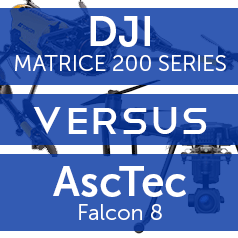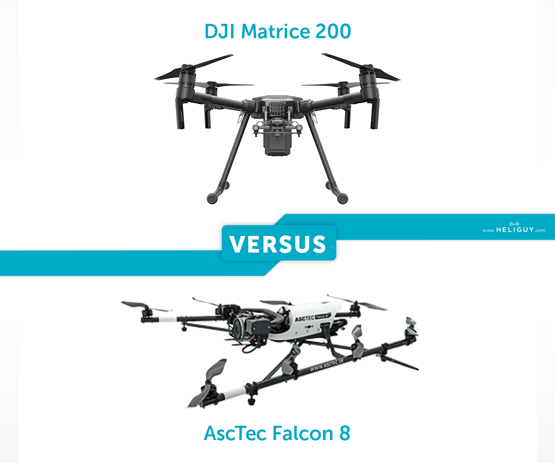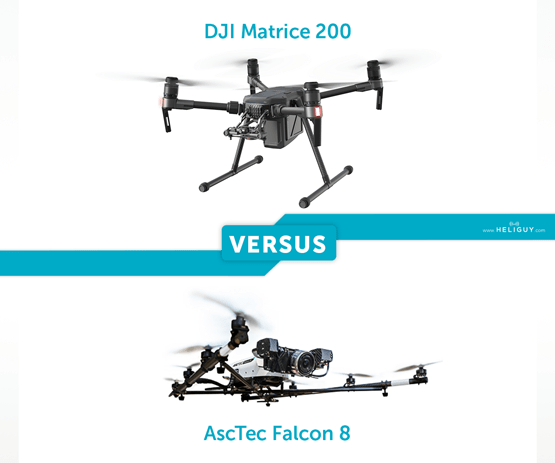
News
DJI Matrice 200 Series VERSUS AscTec Falcon 8
Find out how these two high-end industrial solutions stack up against each other. Does DJI's M200 have what it takes to dethrone AscTec's tried and tested solution? Read on to learn more. ... Read More
__Heliguy-Matrice_200_Series_VS_AscTec_Falcon_8-Header-1000x523.png__With DJI’s recent release of the Matrice 200 Series taking the commercial drone market by storm, it can be easy to forget that other manufacturers are thriving in this growing ecosystem. One of the main competitors of the M200 in terms of intended usage is the AscTec Falcon 8. We’ve covered the M200 series’ core functionality alongside DJI’s other high-end commercial aircraft, the Matrice 600 and Inspire 2, in a previous article which you can read here. Comparably AscTec’s Falcon 8 is already popular aircraft for inspection work on offshore platforms due to its ‘Intrinsically Safe’ design and resistance to magnetic interference.
matrice-200-quadcopter-p4402-7078_thumb-new.jpg Matrice 200 Enquire Here
matrice-210-quadcopter-p4403-7080_thumb-new.jpg Matrice 210 Enquire Here
matrice-210-rtk-quadcopter-p4404-7083_thumb-new.jpg Matrice 210 RTK Enquire Here
So, does the newcomer have what it takes to dethrone the Falcon? Let’s take a look at these industrial UAVs side by side to see which comes out on top. First off, here are the specifications of the AscTec model side by side with the premium Matrice 210 RTK to display the capability of each:
1488196209Matrice_210_RTK-small.png DJI Matrice 210 RTK | 1488812513AscTec_Falcon_8-small.png AscTec Falcon 8 |
#### Dimensions | 887mm x 880mm x 378mm (unfolded) 716mm x 220mm x 236mm (folded) | 770mm x 820mm x 125mm |
#### Weight | 3.84KG (TB50) 4.57KG (TB55) | 1.1KG (empty) |
#### Max Takeoff Weight | 6.14KG | 2.3KG |
#### Max Payload | Approx. 2.3KG (with two TB50 batteries); Approx. 1.57KG (with two TB55 batteries) | 0.8KG |
#### Max Speed | S Mode 23m/s P Mode 17m/s A Mode 23m/s | Manual mode 15m/s Height mode 15m/s GPS mode 4.5-10m/s |
#### Max Wind Resistance | 10m/s | 12m/s GPS mode 15m/s Manual & Height mode |
#### Max Flight Time | 27min (No Payload, with TB50) 38min (No Payload, with TB55) 13min (6KG Payload, with TB50) 24min (6KG Payload, with TB55) | 12-22 min (incl. payload) |
#### Motor Model | DJI 3515 | 8 electrical, brushless motors |
#### Operating Temperature | -20°C to 45°C | -5°C to 35°C |
Gimbals / Cameras
#### Compatible Gimbals / Cameras | Zenmuse X4S, Zenmuse X5S, Zenmuse Z30, Zenmuse XT | FLIR TAU 640, MicaSense RedEdge, Sony Alpha 7R, Sony Alpha 6000, Sony Camcorder HDR-PJ810E, Panasonic Lumix DMC-TZ 71, Panasonic Lumix TZ71 |
Remote Controller
#### Max. Range | 2.4 GHz: 4.3 miles (7 km, FCC); 2.2 miles (3.5 km, CE); 2.5 miles (4 km, SRRC) 5.8 GHz: 4.3 miles (7 km, FCC); 1.2 miles (2 km, CE); 3.1 miles (5 km, SRRC) * unobstructed, free of interference | 1km *Depending on your link setting; visual line of sight (VLOS) ~ 250 m |
#### Operating Frequency | 2.400-2.483 GHz; 5.725-5.850 GHz | 5.8 GHz |
Battery
#### Model | Standard: TB50; Optional: TB55 | AscTec Powerpack 6250 (PP 6250) |
#### Capacity | 4280mAh (TB50) 7760mAh (TB55) | 6250 mAh |
#### Voltage | 22.8V (TB50) 22.8V (TB55) | 11.1V |
MATRICE 200 SERIES VERSUS ASCTEC FALCON 8 KEY FEATURES
Now that we’ve looked through the specifications of these two industrial UAV solutions, let’s dig a bit further into what makes them effective for commercial operation. Read on to discover which of these models is more appropriate for your business needs.
What’s In The Box?
The first thing to consider is what you get straight out of the box. Based on the manufacturers' official descriptions, this is what you can expect to receive from each of these aircraft as standard:
What's Included?
1488196099Matrice_200-small.png DJI Matrice 200 | * Aircraft Body x 1 * Remote Controller x 1 * Propellers (Pair) x 4 * Intelligent Flight Battery (TB50) x 2 * Battery Charger x 1 * Charging Hub x 1 * Power Cable x 1 * USB Cable (with double-A ports) x 1 * Micro SD Card (16GB) x 1 * Vision System Calibration Plate x 1 * Gimbal Damper x 3 * Propeller Mounting Plates x 1 * Carrying Case x 1 * Battery Insulation Sticker x 4 |
* AscTec Falcon 8 + AscTec Trinity * Operating license * Mobile Ground Station including HD Monitor * 1 x Battery charger, Quad, F8 * 6 x AscTec Powerpack 6250 (PP 6250) * Transport case * AscTec Backpack * Basic training | 1488812513AscTec_Falcon_8-small.png AscTec Falcon 8 |
Appearance

The AscTec Falcon 8 is a robust octocopter with a design that favours practicality over aesthetics. With a compact body, 8 motors staggered along two side-mounted bars and a front facing, interchangeable camera rig, it’s immediately clear that there has been a no-nonsense approach to its construction. This practical, feature rich aircraft weighs in at 1.1KG without a payload and if you’re interested in the colour of your Falcon 8 it's available in either white and yellow. The Matrice 200 Series are quadcopters that have been designed to be rapidly folded and easily stored within a purpose-built travel case. Also, a feature which is especially useful if you’re using the M210 the gimbal mounting plates stay attached during transportation allowing you to get airborne within minutes. There’s something distinctly industrial about its aesthetic, with a robust weatherproof design that screams functionality.
Performance

The Falcon 8 can stay airborne for up to 22mins and can carry a 1.76lbs payload in addition to the weight of its built-in components. It’s worth noting that the 22min flight time is dependent on no additional weight being added, with the flight time decreasing depending on the payload. It has a top speed of 36mph dependent on wind speed and direction and its optimum temperature for operation ranges from -5°C to 35°C. AscTec recommends that operators keep this temperature range in mind before attempting flights in extreme conditions. The Falcon 8 also has a maximum operating distance of 3,281ft although special permissions will need to be acquired before missions at this range can be carried out. In terms of functionality, you can plan complex waypoint missions using AscTec Navigator to automate the survey process and Point of Interest enables the camera to fix on a pre-determined position so even if you fly around or away from this point, the AscTec Falcon 8 will stay focused on the target. Other features include:
Automatic Sensor Data Verification: Before take-off, crucial sensor and system parameter values are assessed within seconds. Flight is only permitted following a successful check.
Flexible Plug and Play Solution: There are a number of sensors available. and all functions are accessible via a Mobile Ground Station.
Three Flight Modes: GPS mode, altitude mode and manual mode are all available at the flick of a switch.
Live Flight Check: The aircraft sends all flight data to the Mobile Ground Station in real time
Enhanced Safety: In the case of signal loss, the safety mode takes over and initiates an automatic landing manoeuvre.
falcon8inflight.png AscTec Falcon 8 In Flight DJI’s Matrice 200 performs well in a range of challenging environments. Improved motors and 17-inch propellers ensure stable flight in strong winds while the new dual-battery power system (like that of the Inspire 2) automatically heats batteries in sub-zero temperatures. This is rounded out by an enclosed design for greater weather and water resistance. Here are the key features of the M200 series:
7km Operation Range
38min Max Flight Time (TB55s With No Payload)
IP43 Level Ingress Protection
2kg Max Payload Capacity
A range of familiar smart features is included with the Matrice 200 series including ActiveTrack, Point of Interest and FlightAutonomy. This is all easily controlled through the DJI GO 4 app or alternatively DJI Pilot, their Android app for enterprise users. The M200 Series offers the same front and side obstacle avoidance system you will be familiar with from the Phantom 4 Pro as well as additional upwards avoidance on par with the Inspire 2. Using DJI’s Lightbridge 2 transmission system, the M200 series offers low-latency controls and live feeds from the aircraft. Also, a first for DJI, the Matrice 200 comes with a built-in ADS-B receiver, which automatically provides the pilot with real-time information about nearby manned aircraft activity. Flight planning will be possible using DJI’s GS Pro and the Matrice 200 series will also benefit from DJI’s soon-to-be-released FlightHub software which they claim will: “Oversee your aerial operations remotely to view live inspections and manage your fleet of drones.” Basically, side-by-side, the Matrice 200 is able to match the AscTec Falcon 8's functionality very closely thanks to DJI's advances in their hardware and enterprise software solutions.
Battery
Heliguy-Matrice_200_Series_VS_AscTec_Falcon_8-Battery.png Using a 6,250mAh LiPo battery, the Falcon 8 boasts a large capacity that allows for an impressive flight time of up to 22mins without a payload. However, the M200 series from DJI blows this out the water with the potential for 38mins (even managing 33mins with the powerful Zenmuse X5S gimbal attached) giving operators more time in the air for surveys. The Matrice 200 Series is compatible with TB50 Intelligent Flight Batteries or, if you’re looking to support the dual gimbal set-up, there’s also the option to use the larger TB55 batteries for increased flight times. To see how the M200 performs with its wide range of compatible gimbals, see the table below: Heliguy-Matrice_200_VS_Matrice_600_Pro_VS_Inspire_2-Battery_Life-1000x523-700x366.png
Camera
Heliguy-Matrice_200_Series_VS_AscTec_Falcon_8-Camera_Specs.png The AscTec Falcon 8 is compatible with a range of sensors (primarily manufactured by Sony and Panasonic) that can easily attach to the drone's front-mounted stabilised connector. The Falcon is able to carry the following models as standard:
Sony Alpha 7R: 36MP, ISO 100-25.600, 35 mm full-format sensor, without optical low-pass filter
Sony Alpha 6000: 24MP, 7.6 cm (3 "), Exmor APS-C sensor, Full-HD, SEL20F28, lenses can be changed
Panasonic Lumix DMC-TZ71: 12 MP, 1920 / 50p, 30x optical zoom
There’s also the option to add a more specialised system to the aircraft as explained below.
Inspection Setup TZ71: Panasonic Lumix DMC-TZ71 + IR camera FLIR TAU 2 640 + AscTec IR RAW data logger (this solution delivers JPGS and georeferenced 14-bit RAW thermal images)
The M200 Series, like the previous models in the Matrice range, can carry a variety of cameras making it an ideal tool for industrial uses such as aerial surveys. See below for the compatible Zenmuse models which can also be dual mounted, with an option to place a gimbal on the top of the aircraft for varied perspective:
Zenmuse XT: DJI’s premiere thermal solution for professionals.
Zenmuse X4S: 20 MP stills with a leaf shutter and 4K footage at 60FPS.
Zenmuse X5S: Micro 4/3 5.2K camera with a range of lens options.
Zenmuse Z30: 30x zoom camera for industrial inspections.
It’s worth mentioning that despite its support for the X4S and X5S, the Matrice 200 doesn’t come with the same advanced videography features. Footage is dialled back to the H.264 and H.265 formats compatible with the aircraft’s microSD storage. The X5S’ 5.2K recording isn’t available, as it requires the CINESSD system and cards designed for the Inspire 2. With the Matrice 210 you can also access dual payload compatibility which means you can carry two gimbals at once for enhanced data collection. Additionally, you can attach a gimbal to the top of the craft for alternative viewpoints. If you want to use the latter functionality, you’ll need to install an external GPS receiver, as adding a gimbal to the top of the M210 disrupts the internal GPS. There will inevitably be more cameras released for the Matrice 200 as DJI continue their development which, alongside the modular gimbal positioning, gives it a distinct advantage over the Falcon 8 in terms of sensor solutions.
The Verdict
Both aircraft are exceptional surveying tools for professionals and despite some differences share a great deal of functionality. Both are designed for industrial use, both are undoubtedly sturdy airframes and there's a lot to be said for the features each of them brings to the table. The Matrice 200 quadcopters offer industrial users a great suite of features and compatible hardware to conduct activities such as surveying and mapping. Combined with software like the DJI GS Pro and the upcoming FlightHub, you’re able to program in flight paths that are ideal for undertaking structural surveys or alternatively the creation of 3D models of specific areas and landmarks. m200inspection.png DJI Matrice 200 Power Line Inspection Offering the user access to two sensor solutions at once with its dual mounting capability, the potential for greater instantaneous data capture exceeds the other two models. It also contains all the smart features you’ve come to expect from DJI’s product range as well as newly developed weatherproofing for increased robustness. This durable design and compatibility with DJI’s enterprise range of Zenmuse models also make it a perfect fit for emergency services, search and rescue and disaster relief. When using the RTK model, DJI has stated that magnetic interference won't be an issue for inspection of power lines and large metallic structures which is also one of the USPs touted by AscTec's airframe. An ‘Intrinsically Safe’ design and resistance to magnetic interference (the latter of which is also available with the Matrice 210 RTK) are certainly big selling points for AscTec’s industrial octocopter. The final decision really comes down to what you’re willing to spend between two very comparable solutions.
...
Keep checking back to Heliguy's Insider blog for more information about commercial UAVs, the developing industrial usage of drones and, of course, the latest news from the industry.
